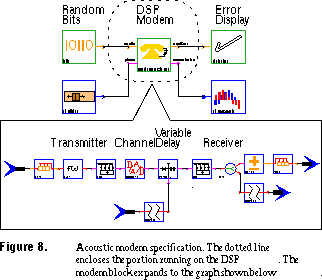[Next] [Previous] [Up] [Top]
5 Examples
5.2 Acoustic modem

The next example, shown in figure 8, is a simple acoustic modem. A pseudo-random sequence of bits is generated on the workstation. This sequence is sent to the DSP, which transmits and then receives the bit stream over a speaker/microphone channel. The received bits are then sent back to the workstation, where the errors are displayed to the user (see figure 9).
In this example there are two independent SDF graphs. Note that one graph spans over actors that are running on the workstation and the DSP. Peek/poke communication schemes could not be used here since we can not afford to lose bits over the channel. The other graph allows the user to adjust the phase of the incoming signal via a slider.
Mapping Multiple Independent Synchronous Dataflow Graphs
[Next] [Previous] [Up] [Top]
